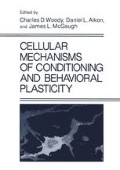Abstract
In order to provide some historical perspective on the remarkable advances made during recent years in our understanding of microphysiological, biophysical, and possible molecular mechanisms involved in single nerve cells, synapses, and neuronal circuits during habituation and conditioning, I would like to review briefly some early studies of Pavlovian conditioning of the occipital a rhythm in man, begun about 50 years ago. I would like then to review the highlights of implanted electrode studies of habituation of electrical and behavioral arousal responses in normal, freely moving cats carried out with Seth Sharpless over 30 years ago.
Access this chapter
Tax calculation will be finalised at checkout
Purchases are for personal use only
Preview
Unable to display preview. Download preview PDF.
References
Celesia, G. G., and Jasper, H. H., 1966, Acetylcholine released from the cerebral cortex in relation to state of activation, Neurology (Minneap.) 16: 1053–1064.
Cruikshank, R. M., 1937, Human occipital brain potentials as affected by intensity—duration variables of visual stimulation, J. Exp. Psychol. 21: 625–641.
Dump, G., and Fessard, A., 1935, L’Électroencéphalogramme de l’homme, Ann. Psychol. 36: 1–32.
Jasper, H. H., 1969, Neurochemical mediators of specific and non-specific cortical activation, in: Attention in Neurophysiology ( C. R. Evans and T. B. Mulholland, eds.), Butterworth, London, pp. 377–395.
Jasper, H. H., 1965, Mechanisms for the selection and preservation of acquired stimulus—response patterns, Excerpta Med. Int. Cong. Ser. 87: 641–644.
Jasper, H., 1981, Reflections on early studies of cortical unit activity during conditioning in the monkey, in: Conditioning: Representation of Involved Neural Functions, Volume 26 ( C. D. Woody, ed.), Plenum Press, New York, pp. 319–332.
Jasper, H.H., and Cruikshank, R. M., 1937, Electroencephalography II, Visual stimulation and the after image as affecting the occipital alpha rhythm, J. Gen. Psychol. 17: 29–48.
Jasper, H. H., and Shagass, C., 1941a, Conditioning the occipital alpha rhythm in man, J. Exp. Psychol. 28: 373–388.
Jasper, H., and Shagass, C., 1941b, Conscious time judgments related to conditioned time intervals and voluntary control of the alpha rhythm, J. Exp. Psychol. 28: 503–508.
Jasper, H. H., Ricci, G., and Doane, B., 1960, Microelectrode analysis of cortical cell discharge during avoidance conditioning in the monkey, J. Electroencephalogr. Clin. Neurophysiol. [Suppl.] 13: 137–155.
Loomis, A. L., Harvey, E. N., and Hobart, G. A., 1936, Electrical potentials of the human brain, J. Exp. Psychol. 19: 249–279.
Murray, G., 1969, The role of cholinergie mechanisms in the learning of a tactile discrimination in the monkey, M.Sc. Thesis, Faculty of Medicine, University of Montreal, Montreal.
Rheinberger, M. B., and Jasper, H. H., 1937, The electrical activity of the cerebral cortex in the unanesthetized cat, Am. J. Physiol. 119: 186–196.
Sharpless, S., and Jasper, H., 1956, Habituation of the arousal reaction, Brain 79: 655–680.
Sie, G., Jasper, H. H., and Wolfe, L., 1965, Rate of ACh release from cortical surface in ‘encephale’ and ‘cerveau isole’ cat preparations in relation to arousal and epileptic activation of the ECoG, Electroencephalogr. Clin. Neurophysiol. 18: 206.
Travis, L. E., and Egan, J. P., 1938, Conditioning of the electrical response of the cortex, J. Exp. Psychol. 22: 524–531.
Walter, W. G., 1938, The technique and application of electroencephalography, J. Neurol. Psychiatry 1: 359–385.
Woody, C. D., Swartz, B. E., and Gruen, E., 1978, Effects of acetylcholine and cyclic GMP in awake cats, Brain Res. 158: 373–395.
Author information
Authors and Affiliations
Editor information
Editors and Affiliations
Rights and permissions
Copyright information
© 1988 Springer Science+Business Media New York
About this chapter
Cite this chapter
Jasper, H.H. (1988). Conditioning and Habituation of the Arousal Response. In: Woody, C.D., Alkon, D.L., McGaugh, J.L. (eds) Cellular Mechanisms of Conditioning and Behavioral Plasticity. Springer, Boston, MA. https://doi.org/10.1007/978-1-4757-9610-0_19
Download citation
DOI: https://doi.org/10.1007/978-1-4757-9610-0_19
Publisher Name: Springer, Boston, MA
Print ISBN: 978-1-4757-9612-4
Online ISBN: 978-1-4757-9610-0
eBook Packages: Springer Book Archive

